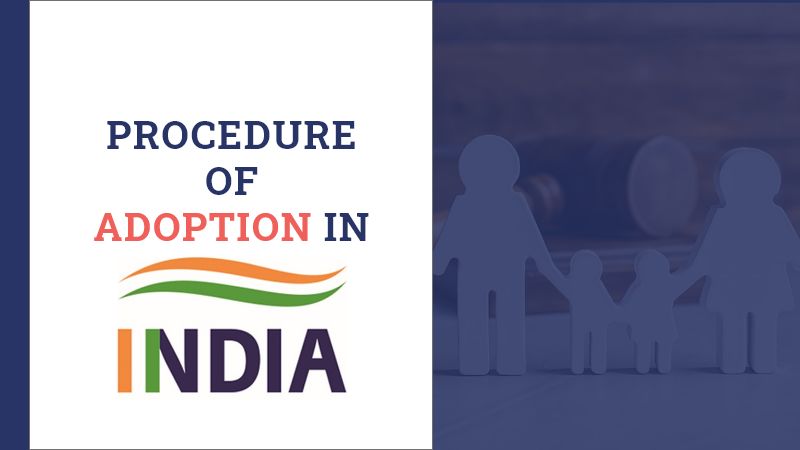
INTRODUCTON
Having a child is the greatest bliss for parent. Adoption seems the most effective way to achieve this bliss. It arises as a panacea for those who seek the fate of children. Adoption may be the best option not only for single and childless couples, but also for homeless children.
Childbirth does not make her a mother. Placing a child for adoption does not make him one less child. While the reasons for adoption may vary from parent to parent, it is often a question of how you can change the life of an adopted child for the better. Yajnavalkya says : because continuity of the family in this world and the attainment of the heaven in the next are through sons, son’s son and son’s grandson, therefore, women should be loved and protected.1 Manu has explained the necessity of a son in the following terms:-
Through a son, a man conquers a world, through a grandson he obtains immortality and through his great grandson he gains the world of the son. Manu has again said:-
“It is the foremost duty of man, who is son-less, to have a son by any means.2
The religious motive behind the adoption is evident from Baudhayana’s text which reads as follows-“I take thee for fulfilment, of my religious duties. I take thee to continue the line of my ancestors”.3
Adoption is not recognized in any other personal law. There is no provision to adopt in Mohammedan law or to be recognized in English law or Parsi law but it is recognized by Hindu law.
PRESENT SITUATION IN INDIAN ADOPTION
Adoption rates in India have always been low, but in recent years they have declined: adoption statistics from the government’s Central Adoption Resource Authority (CARA) show that in 2010 there were 5,693 adoptions in the country, whereas in 2017-2018, there were only 3,276 adoptions and in 2018 -2019, there were only 3,374 adoptions in the country. These are shameful numbers for a population as gigantic as India. And currently, there are only about 20,000 parents online waiting to be adopted, compared to 27.5 million couples who are actively trying to
1 लोकानने दिवः प्राप्ति पुत्र पौत्र प्रपौत्र नः ।
यस्मान्त्त्रप्स्मािप्स्त्रयः सेवयाः कियाश्ा च सरु क्षििः ।। याज्ञ 1-78
2 अपुत्रेण सुिः कायो यादृक् िादृक् प्रयत्निः ॥ मनु ।।
3 Baudhayana II, 7-19.
conceive but who are experiencing infertility, according to the Indian Society of Assisted Reproduction.4
WHO CAN BE ADOPTED?
According to Hindu law, the following child can be adopted: The child can be a girl or a boy, if she/he is Hindu.
He / she not adopted before.
The child is less than 15 years old. The child must not be married.
In accordance with the Guardianship Act and the Juvenile Justice (Care and Protection of Children) Act 2015, the following child can be adopted, for example:
Who is of any religion?
Those who are minors (do not complete their 18th birthday). An orphan or abandoned or surrendered child.
CONDITIONS TO ADOPT A CHILD IN INDIA
In India, the adoption process is overseen by the Central Adoption Resource Authority (CARA), which is the nodal agency responsible for monitoring and regulating adoption in the country and within the country and is part of the Ministry of women and child care. Here are the basic conditions that must be met by the adoptive parents to be able to adopt a child:
- The prospective adoptive parents shall be physically, mentally and emotionally stable, financially capable and shall not have any life threatening medical condition.
- Any prospective adoptive parents, irrespective of his marital status and whether or not he has biological son or daughter, can adopt a child subject to following, namely:-
- the consent of both the spouses for the adoption shall be required, in case of a married couple;
- a single female can adopt a child of any gender;
- a single male shall not be eligible to adopt a girl child;
- No child shall be given in adoption to a couple unless they have at least two years of stable marital relationship.
- In case of couple, the composite age of the prospective adoptive parents shall be counted.
- The minimum age difference between the child and either of the prospective adoptive parents shall not be less than twenty-five years.
4 Adoption Statistics, Central Adoption Resource Authority Ministry of Women & Child Development Government of India, CARA, http://cara.nic.in/resource/adoption_Stattistics.html (last visited 20 June 2020).
- The age criteria for prospective adoptive parents shall not be applicable in case of relative adoptions and adoption by step-parent.
- Couples with three or more children shall not be considered for adoption except in case of special need children as defined in sub-regulation (21) of regulation 2, hard to place children as mentioned in regulation 50 and in case of relative adoption and adoption by step-parent.5
PROCEDURE FOR ADOPTION IN INDIA
The adoption process in India is governed by several laws and their compliance is overseen by the Central Adoption Resource Authority. The procedure for adopting a child in India can be understood in the following steps:
- Phase 1- Register
Prospective adoptive parents must register with an authorized agency. The recognized Indian placement agencies (RIPA) and the special adoption agency (SPA) are the agencies authorized to make such registrations in India. Prospective adoptive parents can visit the Adoption Coordination Agency in their region where the social worker will explain the process to you and guide you the administrative formalities and general preparation required for registration.
- Phase 2 – Home Study and Counselling
A social worker for the registration agency will visit the home of prospective adoptive parents to study home. The agency may also require parents to participate in counselling sessions to understand potential parental motivation, preparation, strengths, and weaknesses. According to CARA regulation, home study is required to be completed within 3 months from the date of registration.
The findings from the home study and counselling session are then reported to the Honourable Court.
- Phase 3 – Child Referral
When the interested child is ready for adoption, the agency will notify the interested couple. The agency will share medical reports, physical test reports and other relevant information with the couple and will also allow them to spend time with the child if they are comfortable with the details shared.
- Phase 4 – Child acceptance
Once the parents are comfortable with a child, they have to sign some documents related to the acceptance of the child.
- Phase 5 – Signing the Petition
5 Eligibility criteria for prospective adoptive parents, Central Adoption Resource Authority Ministry of Women & Child Development Government of India, CARA, http://cara.nic.in/Parents/eg_ri.html (last visited 21 June 2020).
All necessary documents are presented to a lawyer who prepares a petition to be presented to the court. After the petition is ready, the adoptive parents must visit the court and sign the petition in front of the court official.
- Phase 6 – Pre Adoption Foster Care
Once the petition is signed in court, the adoptive parents can take the child to a pre- adoptive foster care centre and understand the child’s habits from the nursing staff before taking the child home.
- Phase 7 – Hearing by court
Parents have to attend court hearings with the child. Hearing takes place in a closed room with a judge. The judge may ask some questions and will mention the amount that needs to be invested in the name of the child.
- Phase 8 – Court decree
Once showing the receipt of investment made, the judge will pass the order of adoption.
- Phase 9 – Parlay (Follow up)
After completion of adoption, the agency is required to submit a follow-up report to the court regarding the well being of the child. It can continue for 1-2 years.6
Document Required
- Current family photograph/ photograph of the couple or person adopting a child
- PAN Card of the prospective adoptive parents
- Birth certificate/Proof of date of birth of the prospective adoptive parents
- Proof of residence (aadhar card/ voter card/ passport/current electricity bill/telephone bill)
- Proof of income of last year (salary slip/income certificate issued by Govt. department/income tax return)
- Certificate from a medical practitioner certifying that the prospective adoptive parents do not suffer from any chronic, contagious, or fatal disease and they are fit to adopt (In case of a married couple, upload Medical Certificate of both the applicants)
- Marriage certificate
- Divorce Decree/Declaration from the competent court or affidavit on oath pertaining to divorce in case of divorce governed by personal law where the decree of divorce is not mandatory/Death certificate of spouse in case of the single prospective adoptive parent (if applicable).
- Two reference letters from acquaintances or relatives in support of adoption.
6 Child Adoption in India: Rules, Process and Laws, Mahak Arora On August 6, 2019, https://parenting.firstcry.com/articles/a-complete-guide-to-child-adoption-in- india/?amp#aoh=15928482235908&_ct=1592848230966&csi=1&referrer=https%3A%2F%2Fwww.google.com &_tf=From%20%251%24s, (last visited 21 June 2020).
- Consent of the older child/children in the adoptive family (if more than 5 years)7
LAW GOVERNING THE ADOPTION IN INDIA
Hindu Adoption Maintenance Act, 1956 (HAMA)
- An act for Hindus only, as a child, the giver and the taker must be Hindus (Any Muslim, Christian, Zoroastrian, Jewish, Scheduled Tribe member Cannot adopt, governed by their customary law) (Section 2 of HAMA),
Adoption parent qualification (sec 6 to 8 of HAMA),
- Only a Hindu, Buddhist, Jain or Sikh husband over the age of 18 can adopt, This act is only with the consent of his surviving wife (husband is adopter and wife is
Consenter only),
- A single woman (unmarried, divorced or widowed) can also adopt (Sec 8 (c)),
- A person having a male child cannot adopt a male child,
- A person who is a girl cannot adopt a girl,
- And age difference between adoptive father and adopted girl at least 21 years (sec 11(iii)),
- (The child must be under 15 years of age (sec 10 (iv)),
- Valid Adoption cannot be cancelled (Section 15).
Juvenile Justice Act, 2015
- A Secular Act (Any body, regardless of religion, may adopt a child under this Act) (Sec.58 (1)),
- Nothing in this Act shall apply for adoption under HAMA (Section 56 (3)),
- All inter-country adoptions shall be done as per this Act and adoption provisions rules made by the Authority (Section 56 (4)),
- Children up to the age of 18 years can be adopted under this Act (Section 2 (12)),
- Declared legally free to adopt orphans, abandoned and surrendered (OAS) children by CWC (Section 38) can be placed in-country and inter country Adoption (Section 56 (1)),
- The children of relatives, as defined in sec 2 (52), may be adopted by an inter-country parents (sec60).
CONCLUSION
Finally, I conclude this topic by saying that adoption of a child is the greatest developmental process. Due to this process, children who are not legalized should be legalized after adoption and also receive all care and protection from their family. It also maintains the population of the country. If we see, in India, orphanages are full of children, because they do not have parents to take care of them. Today many parents give birth to a girl and throw her in the trash and do not
even think. This crime is increasing day by day. Even in today’s generation, people do not understand the value of girls even after such high education. Half of the child population is alone, with no legal parents to care for them. Adoption is the best way to give them a good life. “EVERY CHILD HAS RIGHT OF ADOPTION”.



